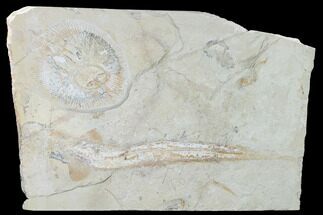13.5" Jurassic Ammonite (Hammatoceras & Pseudogrammoceras) Display
This is an aesthetic display piece featuring two Hammatoceras ammonite fossils and a vibrant red-orange Pseudogrammoceras. It stands 13.5" tall with the largest ammonite being 7.25" wide. The base of the rock has been cut flat so that it stands up nicely on a flat surface.
These ammonites were quarried in the Rhône-Alpes region of France and are Lower Jurassic in age, approximately 180 million years old. The sculpture is a composite, meaning that while the fossils are all real, some of them have been mounted on the rock. All of the ammonite fossils have some degree of restoration work.
These ammonites were quarried in the Rhône-Alpes region of France and are Lower Jurassic in age, approximately 180 million years old. The sculpture is a composite, meaning that while the fossils are all real, some of them have been mounted on the rock. All of the ammonite fossils have some degree of restoration work.
About Ammonites
Ammonites were ancient marine cephalopods, similar to today's squids and octopuses, but with a defining feature: their distinctive, tightly coiled spiral shells. These shells, resembling those of modern nautiluses, served as both a protective home and a buoyancy aid, allowing ammonites to navigate the prehistoric seas with ease. First emerging around 240 million years ago in the Triassic Period, ammonites thrived for over 175 million years, adapting through numerous forms and sizes. As predatory creatures, they likely fed on smaller marine organisms, using their tentacles to capture prey. However, their long reign came to an end 65 million years ago at the close of the Cretaceous, coinciding with the mass extinction event that also eliminated the dinosaurs.
Ammonites were ancient marine cephalopods, similar to today's squids and octopuses, but with a defining feature: their distinctive, tightly coiled spiral shells. These shells, resembling those of modern nautiluses, served as both a protective home and a buoyancy aid, allowing ammonites to navigate the prehistoric seas with ease. First emerging around 240 million years ago in the Triassic Period, ammonites thrived for over 175 million years, adapting through numerous forms and sizes. As predatory creatures, they likely fed on smaller marine organisms, using their tentacles to capture prey. However, their long reign came to an end 65 million years ago at the close of the Cretaceous, coinciding with the mass extinction event that also eliminated the dinosaurs.
$825
SPECIES
Hammatoceras sp. & Pseudogrammoceras sp.
LOCATION
Rhône-Alpes Region, France
SIZE
Largest Ammonite: 7.25" wide, Entire piece: 13.5 x 8.75"
CATEGORY
SUB CATEGORY
ITEM
#301635
We guarantee the authenticity of all of our specimens.
 Reviews
Reviews














